Alba Analog Adaptors, the screenshot show
NMEA 2000 has been working well on Gizmo this summer, making it easy to get heading, wind, depth, GPS, and more to all the MFD systems I’ve been testing. AIS over N2K has some issues, but then again the Garmin VHF 200 is good evidence of what’s possible. However, I’ve just begun to explore how NMEA 2000 can integrate Gizmo’s engine, tanks, batteries, and other non-navigational systems. A few weeks ago, for instance, I plugged an Albatross demo case into the boat’s backbone to see how data from those three Analog Adaptors above would display…
The results were fairly interesting. Every MFD developer is at least attempting to display some basic engine and fuel tank info, though it’s probably not a high priority yet. Lowrance HDS seems the most advanced, which makes sense as several outboard models now output NMEA 2000. I think the new Simrad NSE has the same data display abilities as HDS, and the Furuno NN3D MFD may be able too, though I didn’t have either installed when I took the screenshot show represented below.
I hope to actually install at least one of the Alba Analog Adaptors eventually, though I suspect the calibration is not trivial, as discussed in the original entry. But Albatross Control Systems does have U.S. distributors now, which may help. I also hope to try some of the many new Maretron system sensors, and am excited that its J2K100 might access digital info that’s already in my older but somewhat electronic Volvo TAMD74CA EDC diesel, but which I can’t see (like fuel flow). If it works, Gizmo can have the fuel management I checked out last summer. Fingers crossed!


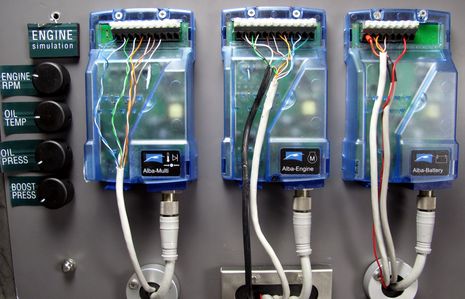
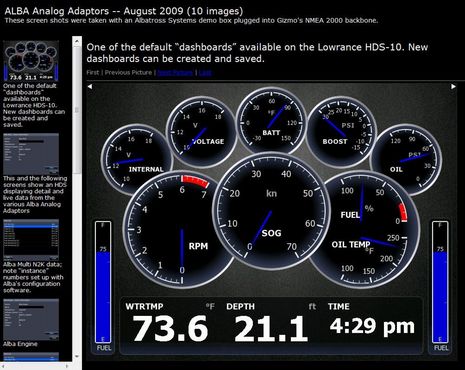
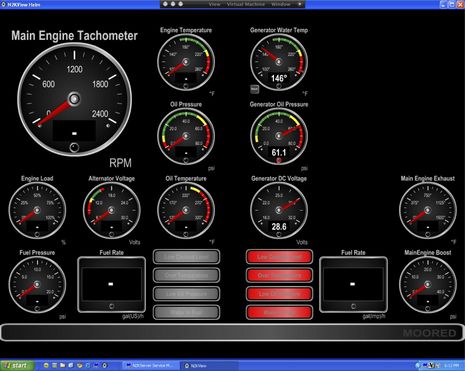
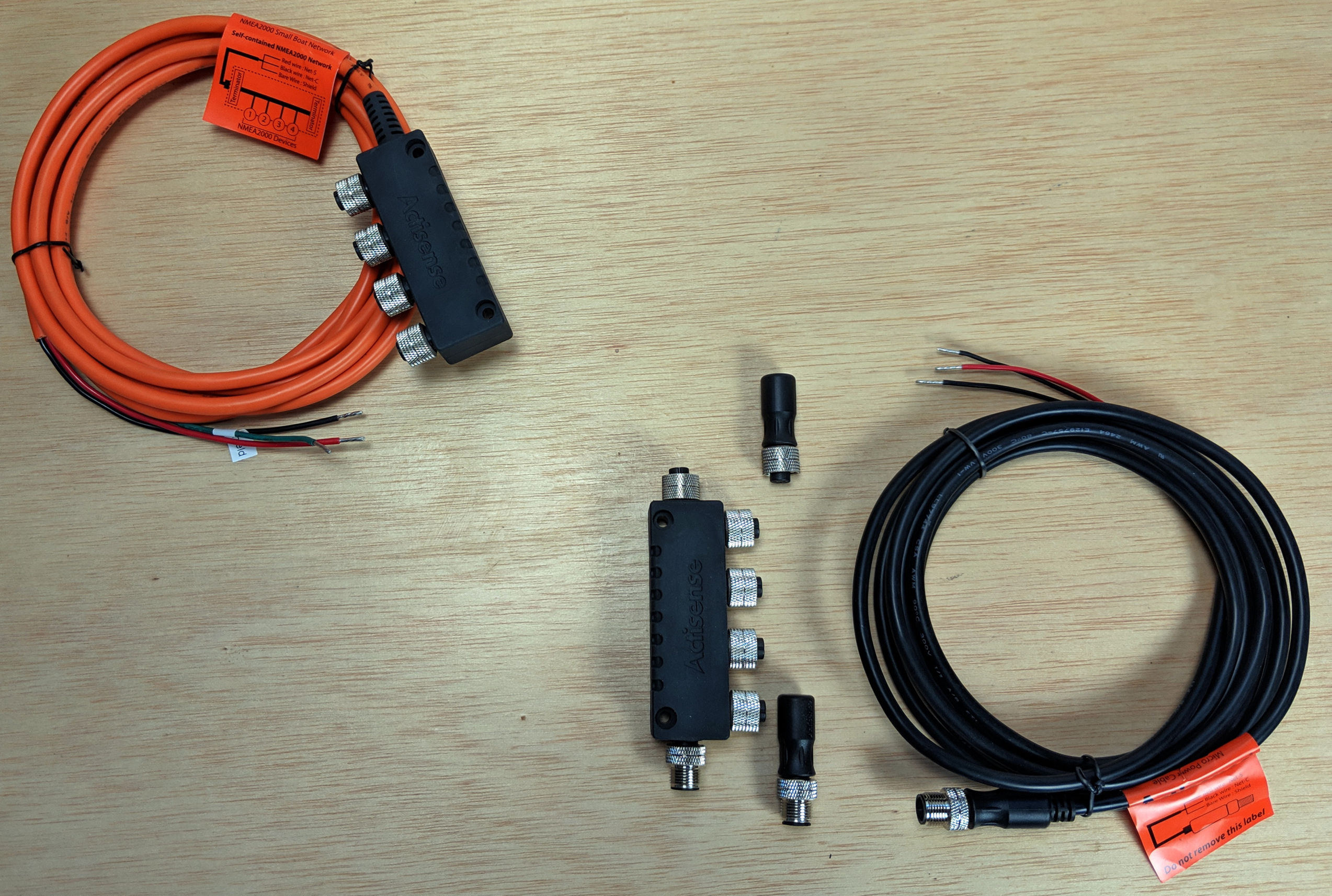
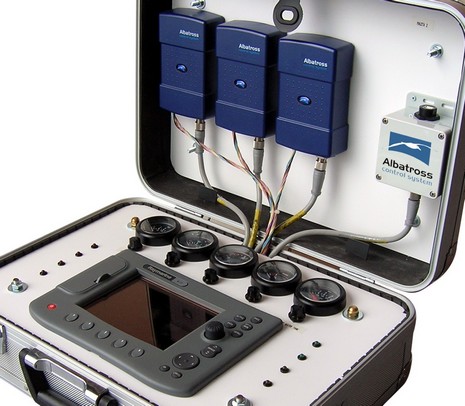









Hi Ben,
I have been told tha with my engines (cat 3126ta non elctronic engines that there is no way to get the analog signals from my engine instruments such as engine temp, rpm, etc… could that be true? it seems that you have been able to do it with Gizmo so what type of converter should i be looking for if i have nse12’s installed on my boat.
Rick, the Albatross engine converter is definitely designed to turn analog info from non-electronic engines into NMEA 2000 messages. But I didn’t actually install the converter on my boat; I just used their demo box to feed the displays on my boat, and thus simulate what I might get if I did set up an Albatross system.
In fact, Gizmo’s Volvo Penta engine is at least partially electronic (circa 1999) and I’ve been working with Maretron to find the output of what’s hopefully CANbus J1939 data that can be converted to NMEA 2000 using Maretron’s box. No success yet, but I haven’t given up.
Ben, I called Maretron on this as well and got a similar but less definite answer. they said that the The (cat 3126ta non elctronic engines analog signals cannot be converted to to n2k signals which realy makes no sense to me being in the the high end computing industry for 25 years. THere is a way to do it ijust haven’t found the converter or it hasent been built yet. It’s very frustrating. I have a budy who builds sensors fro the airline industry. When I explained what i was looking for he said it could be done. Should I start building these sensors?
A couple of years ago I installed Albatross analog to NMEA 2000 converters on a couple of non electronic Cummins engines. I picked up oil pressure, water temp and tach info to be read by a Garmin 2010, I believe. It was pretty straight forward; wiring directly to the gauges at the helm station. No need to worry about paralleling resistive issues. Once I got the hang of it, the calibration was pretty staightforward.
Thanks, Alden. I’ve heard similar reports from a couple of other professional installers, though I’ve also heard that Albatross’s calibration process is somewhat tricky to set up.
Personally, I’m fairly content with the existing gauges and alarms on my boat, but I’d love to get some of the other data that may be available in the engine. It’s a Volvo Penta TAMD 74 CA EDC 450 with electronic controls, what appears to be an ECM, and a diagnostic port. One experienced Volvo mechanic told me that the Volvo diagnostic tool could report fuel flow from it, as well as other info not shown on the gauges. I really want access to that fuel flow (I think ;-).
If your “Volvo diagnostic port” is an OBD II port, (which if it was originally a truck engine, it probably is), this might do it.
Not NMEA but with this & a cheap Nuvi, you’d at least have the basic data.
“By simply plugging the Garmin ecoRoute hd module into the vehicle�s standardized onboard diagnostics port (OBD II), safely mounting the transmitter clear of vehicle controls and pedals, and completing the easy one-time pairing with n�vi, drivers can start receiving the vital data from their vehicle and run diagnostic checks through n�vi�s intuitive interface before a trip to the auto shop is necessary. Drivers also get more accurate ecoRoute data, making fuel conservation easier than ever, and they can monitor their engine data (including temperature, RPM, emissions) and diagnostics through the Trip Computer screen and customizable Gauges screen. Drivers can then view Diagnostic Trouble Codes � with on-screen descriptions of some error codes � and reset the �check engine� light. ecoRoute hd will be compatible with many current and future n�vi models, including 1260, 1370, 1390, 1490 and 1690.
Real-time data monitored by ecoRoute HD, which has an expected availability date of March 2010 for a suggested retail price of $149.99, includes vital diagnostics such as:
� Intake air temperature information
� Coolant temperature data
� Throttle position and engine load
� Intake manifold pressure
� Battery and charging system information
� Mass airflow rate
� Timing advance
� Emissions”
Thanks, John! I doubt the ten year old Volvo has a standard OBD II port, but that sure is an interesting Garmin development. Wireless and inexpensive even. More info for readers here:
http://bit.ly/5PN5a5
My next step with the Volvo is hopefully to find someone there who can tell me what protocol and data is running around in my particular engine. I do know that the model was only produced for one year before replacement with what looks like a very similar model. My fear is that the model change was all about a transition in the electronic elements.
As noted I’ve already sniffed it for valid J1939 data, thanks to Maretron, and didn’t find any. It was an interesting process, though, involving a USB100 operated in command line mode from Hyper Terminal.
I love guys like you….”I’ve got a friend in the…..” Re-inventing the unknown device.
You don’t know if the project you just co-opted your buddy into is doable…much less something your buddy really wants to do.
He probably has better things to do than help you reinvent something purposely made proprietary…25yrs or not. CAT had reasons.
Lord only knows why this troll was reading a year-old entry or what he thought he read — was it me “co-opting” someone into something, say what? — but his whining came in at a very ironic moment. I was just reading about various new analog-engine-to-NMEA-2000 options at http://www.chetcodigital.com and I’m dead sure that I’m not the only boater who would love to have his engine’s vital signs translated into a format that can display most anywhere, be logged, be alerted for more than just catastrophic conditions, etc. etc.
Especially if it’s not wicked expensive or complicated. Chetco’s stuff looks reasonable (and there’s even a wireless option). And I know that several other companies like Rose Point Navigation and Actisense are working on analog-engine-to-N2K devices. I sense this will become a fairly active niche that will give some boaters a much better understanding of what their engine (s) is up to. I’m hoping to be one of them.
At any rate, thanks for stopping by, Anon!
We have TAMD74PEDC engines in our boat and would really like to do the same thing without spending $1600 per engine with Volvo to get the gateways. In fact, I am currently working on a device that will do this and now have it for equipment that does speak 1587. However, the Volvo engines appear to speak a much modified 1587 code and we are now trying to determine exactly what it is.
Hopefully within the next few weeks, we will know if it’s going to work with the Volvos.
Hi Bob,
Did you have any luck with getting the engine data for your TAMD74PEDC engines? We have the same engines and would like to have the data display on our Raymarine E120 through NMEA 2000.
Have you looked at the Maretron J2K100? I read in another posting on the net that it may work too.
Hi Ben, did you make any progress with your project to access TAMD74 EDC data for re-transmission to N2K?? I’m interested and trying to do the same.
Did you identify what protocol the VP ECU uses? Is it J1939, J1587 or even KWP2000??
I’m currently working on the N2K side of things – sending data (static for now) to my MFDs using an Arduino. If I get that working I then need to work out how to get the data out of the ECUs.
Cheers
Hi Bob,
Volvo Penta KAD engines (EDC I) are speak in proprietary protocol compatible with J1708, but it is not J1587.
EDC II are speak in J1587.
We recently released the N2K gateway wich support both protocols:
http://www.yachtd.com/products/j1708_gateway.html
WBR,
Aleksandr